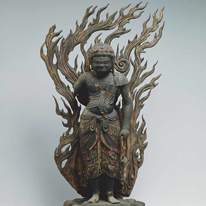Past Exhibitions
- Wrathful Buddhist Deities
- September 13, 2016 - November 27, 2016
Buddhist sculptures fall into various categories, including buddhas, bodhisattvas, wisdom kings (Skt: vidyārājas, J: myōō), and devas (J: tenbu, literally “heavenly beings”). Wisdom kings have fierce, frightening countenances, and with good reason: it is their job to save those of us for whom compassion and mercy is not enough. Devas who protect buddhas and Buddhism, such as the Four Guardian Kings or the Twelve Generals, also look intimidating. This mini exhibition features various formidable defenders of the Buddhist dharma. How have their faces and body positions been carved to inspire fear and awe in the beholder?
- Japanese Sculpture
- September 13, 2016 - October 2, 2016
Before the Edo period, almost all Japanese sculpture was religious in nature. Buddhist sculptures were produced in Japan from the time Buddhism took hold in the seventh century, but the icons they represented came from India by way of China, bringing with them the influence of those countries.
One of the distinctive characteristics of Japanese sculpture is its use of wood as a primary material. Because sculptures were made of wood, various construction styles and techniques were developed, including joint-block construction (yosegi zukuri) and inlaid crystal eyes.
Japanese Buddhist sculptures from various historical periods exemplify the repeated waves of influence from the Asian mainland and subsequent Japanese innovations, leading to a rich variety of sculptural styles.












